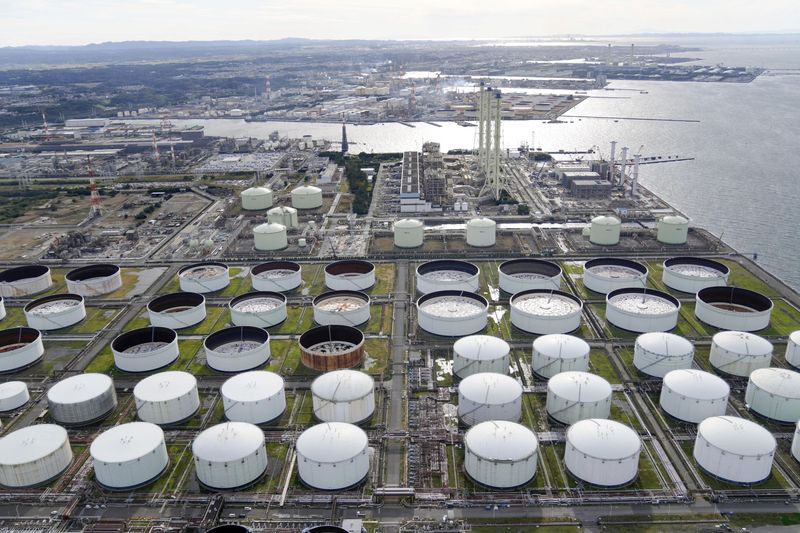Commodities
Oil buoyed by US signals on interest rate cuts


© Reuters. An aerial view shows an oil factory of Idemitsu Kosan Co. in Ichihara, east of Tokyo, Japan November 12, 2021, in this photo taken by Kyodo. Kyodo/via REUTERS
By Paul Carsten
LONDON (Reuters) -Oil prices edged higher on Thursday, boosted by the U.S. Federal Reserve signalling a possible start to interest rate cuts.
There was limited immediate price impact after two OPEC+ sources said that the Thursday meeting of the group of oil-producing countries – including Saudi Arabia, Russia and allies – left production policy changes off its agenda.
futures were up 68 cents at $81.23 a barrel by 1140 GMT. U.S. West Texas Intermediate crude futures gained 65 cents to $76.50.
OPEC+ will soon have to decide whether to extend beyond March the 2.2 million barrels per day (bpd) of voluntary oil production cuts announced last November.
Federal Reserve Chair Jerome Powell on Wednesday said that interest rates had peaked and would move lower in coming months, with inflation continuing to fall and an expectation of sustained economic growth.
Lower interest rates and economic growth help oil demand.
But Powell declined to promise that rate cuts would come as early as the Fed’s March 19-20 meeting, as investors had hoped.
China, the world’s second-biggest economy, revealed new support measures to help to reduce fallout from the liquidation of property developer Evergrande.
Analysts at JPMorgan said they expected China to remain the single largest contributor to global oil demand growth in 2024, forecasting that Chinese demand would grow by 530,000 barrels per day (bpd), having jumped by 1.2 million bpd last year.
“Geopolitics aside, our view remains that 2024 will be fundamentally a healthy year for the oil market and we recommended using December’s sell-off as a buying opportunity,” JPMorgan said in a client note.
In another glimmer of better economic news, the downturn in Germany’s manufacturing sector eased in January, a survey showed on Thursday.
In the Middle East, worries over attacks by Yemen-based Houthi forces on shipping in the Red Sea are driving up costs and disrupting global oil trading. The Houthi group also said it would keep up attacks on U.S. and British warships in what it called acts of self defence.
“The energy market remains on edge as it waits for a U.S. response to the drone attack on American troops in Jordan,” ANZ Research said in a note.
Commodities
Oil prices rise; U.S. crude inventories plunge, Russia-Ukraine truce eyed
Commodities
India’s Reliance to stop buying Venezuelan oil over US tariffs, sources say
Commodities
Oil prices climb on Venezuela supply worries

 Forex3 years ago
Forex3 years agoForex Today: the dollar is gaining strength amid gloomy sentiment at the start of the Fed’s week

 Forex3 years ago
Forex3 years agoUnbiased review of Pocket Option broker

 Forex3 years ago
Forex3 years agoDollar to pound sterling exchange rate today: Pound plummeted to its lowest since 1985

 Forex3 years ago
Forex3 years agoHow is the Australian dollar doing today?

 Cryptocurrency3 years ago
Cryptocurrency3 years agoWhat happened in the crypto market – current events today

 World3 years ago
World3 years agoWhy are modern video games an art form?

 Commodities3 years ago
Commodities3 years agoCopper continues to fall in price on expectations of lower demand in China

 Economy3 years ago
Economy3 years agoCrude oil tankers double in price due to EU anti-Russian sanctions























